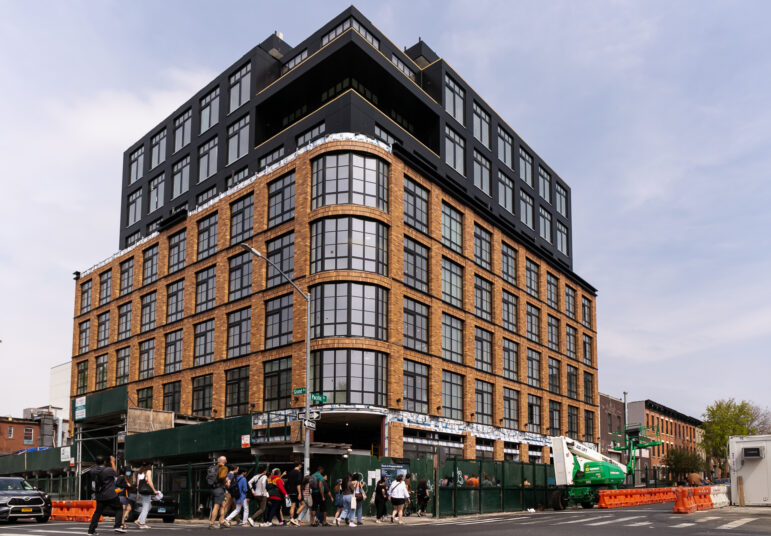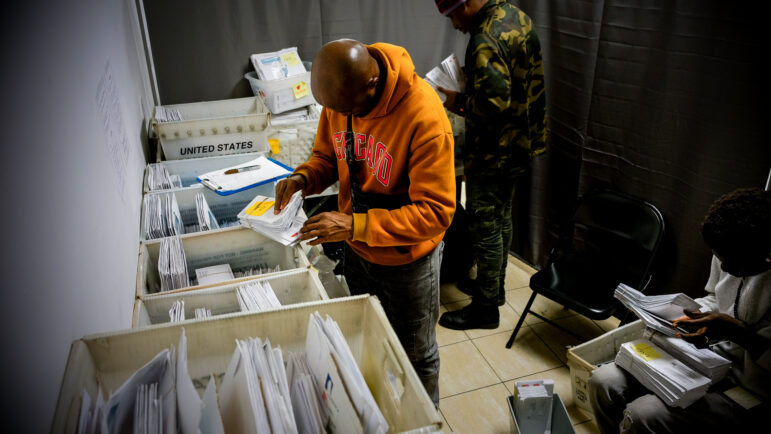Hundreds of thousands of waitlist applications began pouring in at midnight on Monday and will continue to be accepted online up until 11:59 p.m. this coming Sunday, June 9.

Adi Talwar
Recently-constructed apartments on Atlantic Avenue and Pacific Street in Crown Heights, Brooklyn.The New York City Housing Authority had received 409,099 applications from households seeking coveted, federally-backed rental assistance vouchers as of 7 a.m. Wednesday—the equivalent of more than 7,400 submissions per hour and more than double the volume that will ultimately land on the city’s revamped Section 8 waitlist.
Applications began pouring in at midnight on Monday, June 3, and will continue to be accepted online up until 11:59 p.m. this coming Sunday, June 9. Families and individuals can also request a paper application this week as a reasonable accommodation, and will have until Friday, June 28, to postmark those submissions.
Robyn Saldino, a tenant in Harlem, refreshed the application page right at midnight on Monday. Saldino has Long COVID, and has not been able to work as a result, falling behind on rent. She had researched Section 8 qualifications, and was prepared to spend hours uploading documents to prove her eligibility.
But at this stage, NYCHA is not requiring applicants to verify any personal information. Saldino found the processing refreshingly simple, and estimates that it took 12 to 15 minutes. She was also pleased to receive a prompt confirmation email, which gave her confidence that it “actually went through.”
“Each section only had two or three questions. And it was broken down into neat little tabs,” she said. “For people like me, and people that are disabled, we’re really limited on energy and the application made it possible for us to apply.”
NYCHA plans to weed out duplicate applications and will ultimately select 200,000 households for the waitlist through a randomized lottery. The authority will conduct eligibility interviews ahead of waitlist placement, as well as request supporting documentation.
Launched in the 1970s by the U.S. Department of Housing and Urban Development (HUD), the Section 8 Housing Choice Voucher (HCV) program helps low-income individuals and families afford apartments on the private market, covering rent beyond 30 percent of the voucher holder’s income.
Prior to this week’s window, the waitlist had been closed for nearly 15 years. It dwindled over time—to less than 4,000 last month—and was due for a replenishment, Lakesha Miller, NYCHA’s executive vice president of leased housing, told reporters at a May 29 press briefing.
The stakes are high, according to Assemblymember Marcela Mitaynes, who represents Brooklyn’s Red Hook and Sunset Park neighborhoods. Mitaynes has been using her district office as a “base” for people seeking application assistance this week.
“We just want to make sure that everyone has an opportunity to apply, because it could be a life changer,” she told City Limits on Tuesday.
“It’s this little glimpse of hope,” Mitaynes said of the reopened waitlist, tearing up as she recalled her own past experience with eviction, which spurred her earlier work as a tenant organizer before she ran for elected office. “That maybe they might get a break, and they might be able to survive.”
Even once on the waitlist, a voucher is not guaranteed. Households will receive a priority code, with preference going first to applicants who have mobility challenges in their current apartment, and then to seniors and people with disabilities.
NYCHA has said it aims to issue 1,000 vouchers each month, until it hits its maximum distribution. As of late May, the authority was capped at 115,346 active vouchers and had 96,509 Section 8 participants either leased up or searching, about 84 percent of that total.
Mitaynes said her team has been recruiting volunteers to help with their application effort, and had “a line outside the door” Monday morning, with nearly 200 people stopping by that day alone. Most of this outreach has been focused on aiding non-English speakers and those who need help getting online.
“I gave my staff specific instructions that we are shutting down everything we’re doing [in] the office and then shifting into doing the applications,” Mitaynes said. “Between language barriers and between not having access to technology or not having access to internet… it was really crucial.”
Her staff has been stressing to applicants that they don’t need to earn income to apply, and that immigrant households can apply as long as at least one person in the home is a U.S. citizen or a non-citizen with an eligible immigration status.
Notably, the program does not have residency requirements, meaning non-New Yorkers can also apply. Heads of household must generally be at least 18 years old to qualify, and income limits range from $54,350 for a single person to $102,500 for a family of eight.
New York City separately funds its own voucher program, the City Family Homelessness and Eviction Prevention Supplement, or CityFHEPS, which 41,000 households currently use. But Section 8 is considered a gold standard in the industry, thanks to its longevity and federal backing.
“It’s such an important tool because it opens up private housing opportunities to low income families, and really gives them the opportunity to search for their own housing and a community of their choice,” said Baaba Halm, New York market leader for housing nonprofit Enterprise Community Partners.
While CityFHEPS voucher holders are limited to New York State in their housing search, Section 8 recipients can request to transfer their voucher elsewhere in the country.
Diana Ramos, a leader with the Safety Net Project at the Urban Justice Center, jumped at the opportunity to apply for the Section 8 waitlist this week, even though she has a CityFHEPS voucher. She described the application process as quick and simple, estimating that it took 10 minutes, at most, to complete.
“I’m a little slower typing because I have hand issues,” she said. “But I mean, I did it on my phone, if that tells you anything.”
“If I have to, say, move out of New York City and move closer to my dad, I’m able to take my Section 8 voucher with me,” Ramos added. “And more landlords would take a Section 8 voucher because it’s got a better reputation than a CityFHEPS voucher.”
While it’s illegal for city property owners to reject a tenant for using a rental subsidy, the practice—called source of income discrimination—is among the most common forms of housing bias in New York.
It will be crucial for the city to invest in combating that practice as it rolls out new vouchers, according to Mitaynes. “The second part of this is really putting those landlords on notice,” the lawmaker said.
She pointed to a public service campaign the city ran in the 1980s to crack down on landlords discriminating against tenants based on race, sex, disabilities or other factors outlawed under the Fair Housing Act. The campaign included a television ad featuring former Mayor Ed Koch and A-Team actor Mr. T.
“We need something like that,” said Mitaynes. “This is only going to work if we have the mayor’s full support behind this, and that includes enforcement.”
The new Section 8 waitlist is expected to be established by Aug. 1.
Meanwhile, Manhattan Assemblymember Linda Rosenthal is frustrated that a state-level subsidy proposal modeled after Section 8, dubbed the Housing Access Voucher Program, did not make it into this year’s state budget, despite endorsements from both the Senate and Assembly.
This week’s application demand is “humongous,” Rosenthal said Wednesday. “If this doesn’t prove that people are in dire need of vouchers to help them pay the rent, then I don’t know what does.”
Additional reporting by Tatyana Turner.
To reach the reporters behind this story, contact Emma@citylimits.org and Jeanmarie@citylimits.org.
Want to republish this story? Find City Limits’ reprint policy here.









One thought on “Demand for Section 8 Waitlist More than Double Available Slots—And Counting ”
It’s very important to me thanks